A Brief History of Internet Access Plus What’s Next to Come

In this Article
Internet Connectivity - from Dial-Up to Starlink and 6G Cellular
If you're reading this article, you're connected to the Internet. This technology has transformed the way we live, work, and communicate. Over the past few decades, Internet connectivity has evolved significantly, from the early days of dial-up modems to the lightning-fast speeds of 5G networks.
In this article, we’ll explore the fascinating journey of Internet access and connectivity, highlighting the key milestones, technologies, and their impact on our daily lives.
Dial-Up Internet Access - the First Widespread Solution
Spanning from the early 1990s to well into the 2000s as the main way to connect to the Internet, dial-up uses the facilities of a telephone network to establish a connection to an Internet service provider by dialing a telephone number. These connections use modems to code / decode audio signals into data sent to a router or a computer - if you don't remember those screeching sounds, you probably heard of them.
The speed of dial-up Internet was painfully slow - it ranged from 28.8 kbps to 56 kbps! And, believe it or not, in 2022 there were more than 300,000 households in the United States with a computer and a dial-up connection alone.
Benefits:
- Widely available (if you had a phone line).
- Affordable.
Disadvantages:
- Slow speeds.
- Tied up the phone line - you could either go online or use the phone.
- Frequent disconnections.
ISDN (Integrated Services Digital Network) - a Dial-Up Upgrade
ISDN is the next generation of dial-up Internet access, working over digital phone lines (where the information was sent in a digital format). This allowed it to send data, voice and video over simultaneously over a phone line. ISDN was mostly popular as an alternative to dial-up during the 1990s and 2000s.
In terms of speeds, ISDN could handle up to 128 kbps, more than double than dial-up. ADSL quickly replaced ISDN as the customer-facing solution for connectivity. ISDN has largely disappeared on the customer side, remaining in use only in niche roles like dedicated teleconferencing systems and similar legacy systems.
Benefits:
- Better call quality.
- Faster connection.
Disadvantages:
- Limited availability.
- Costly at the time.
DSL / ADSL (Asymmetric) Digital Subscriber Line - "Facelift" for ISDN
DSL (Digital Subscriber Line) is a group of technologies that are used to send and receive digital data over telephone lines. It can also be considered among the first broadband Internet access solutions. Asymmetric DSL (ADSL) is the most used type of DSL for consumers, where the download rates are higher than the upload rates. It was widely used during the early to late 2000s.
In terms of speeds, depending on the generation of ADSL broadband, you could get typical speeds of around 10 Mbps for ADSL1 and 24 Mbps for ADSL2+. At this time, DSL technology is becoming obsolete, being phased out as technology advances with options like fiber optic and 5G. Even though there aren't any commercial DSL plans available in the US, the vast majority of US households still have DSL coverage.
Benefits:
- Always-on connection.
- Faster downloads.
Disadvantages:
- Upload speeds were slower.
- Distance from the Internet service provider affected performance.
Cable Internet - Convenient and Accessible
Cable Internet has brought broadband connectivity in millions of homes around the world. Given that it used already existing coaxial cable infrastructure for delivering TV signal, it was widely adopted starting with the 2000s and it's still in use in many households.
In terms of speeds, users likely get speeds from 50 Mbps to 200 Mbps.
Benefits:
- Higher speeds.
- Shared connection (multiple users in an area).
Disadvantages:
- Speeds could drop during peak hours.
- Shared bandwidth.
Fiber Optics - the Best at the Moment
Fiber optics is the latest upgrade in terms of wired Internet access for home and businesses. Data is transmitted through fiber optics from the ISP directly to the customer's premise, where it goes through a modem and then the data is sent to a (wireless) router or another network equipment. It's been around on a wider scale since the 2010s and many ISPs are transitioning to this to upgrade their older dial-up, ISDN, ADSL and cable infrastructure.
Speeds for fiber Internet currently go up to 10 Gbps, which makes it 180k times faster than dial-up Internet! Interestingly enough, both fiber and cable Internet are theoretically able to transmit data at the same rates, but the main difference is the split between download and upload bandwidth - for cable Internet download speeds are way better than upload ones, whereas for fiber they're symmetrical.
Benefits:
- Blazing fast speeds.
- Low latency.
- Reliable.
Disadvantages:
- Infrastructure costs.
- Limited availability in rural areas.
Mobile / Cellular Networks: 2G, 3G, 4G / LTE and 5G - Wireless Broadband Internet
We are talking here about wireless Internet access via mobile networks a.k.a. mobile Internet. It has been around since 1991, as part of the second generation of mobile phone technology (2G) and we're now during the fifth generation (5G) since 2018.
2G provides basic voice and text communication, as well as some mobile data. It could deliver speeds of up to 384 kbps (GSM EDGE). 2G has been superseded by newer technologies, but such networks were still available in 2023 around the world.
3G debuted in 2001 and brought better voice quality and faster data transfer - up to 42.2 Mbps for its HSPA+ market implementation, also known as 3.5G. Such mobile networks are still widely in use around the world in 2024.
4G / LTE further enhanced the data rates, bringing them to up to 100 Mbps for using it while moving, in cars and trains, and 1 Gbps for stationary users. From 2006 to 2018 it was the main cellular data standard.
5G: is the current mobile data standard, providing ultra-fast speeds, low latency, and massive device connectivity since its worldwide deployment in 2019. The data rates peak up to 20 Gbps, but average speeds recorded are around 400 Mbps.
Benefits of 5G:
- Enhanced mobile connectivity for a wider range of devices.
- Enables IoT, autonomous vehicles, and smart cities.
Disadvantages of 5G:
- Coverage gaps.
- Infrastructure rollout challenges.
Satellite Internet - Another Type of Wireless Broadband Internet
Satellite Internet access has been available since 1996 as a commercial solution. It's still the best solution to get online in remote areas or when not on land. There are multiple types of satellite Internet technologies, from geostationary "classic" ones to medium and low-orbit satellites.
In terms of speeds, satellite Internet can transmit data as fast as 220 Mbps download and 20 Mbps upload.
Benefits
- Availability in remote areas
- Good performance for download speeds
Disadvantages
- High latency
- Depends on satellite coverage, weather and other obstructions
What's Next for Internet Access Technologies?
The future of Internet connectivity holds exciting opportunities. Naturally, all the current technologies for Internet access will evolve to provide better speeds and reliability:
- we're waiting for the next generation of cellular connectivity - 6G - which is probably going to roll out around 2030.
- satellite Internet is going to be THE solution for remote areas - Starlink is leading the way here with its worldwide network of low-orbit satellites.
- fiber Internet will replace all the previous cable and DSL Internet solutions given its superior performance and more efficient infrastructure.
One thing is for sure: the Internet is going to become better and better as years go by, but so are the requirements / demands and the number of connected devices.
How to Get the Best Internet Connectivity in Any Condition
We all know Internet connections can be faulty - either due to temporary issues from the Internet service provider or from interference, weather, overcrowded networks, etc. So what can you do in these situations?
Every one of us has access to at least two Internet sources: a connection at home or at the office and one from our mobile phone. So why not combine these (and any additional ones) together at once for faster, more reliable and secure Internet access?
Speedify is the only app that can combine all of your Internet connections simultaneously right on your computer or mobile device. You can even harness the power of others' Internet connections with the Pair and Share feature. This works almost like a turbocharged personal hotspot, but instead of just one device sharing its connection with another, once paired, both devices can share and receive each other’s connections simultaneously.
Download Speedify
Speedify is the only app that combines your wifi, cellular, wired, and even your friend’s phone signals – into one ultra-fast and super secure link that keeps you all connected for the best possible live streaming, video calling, or just posting to your favorite app.
Subscribe to Speedify on YouTube
Get news, success stories, and our weekly livestreaming show Speedify LIVE! Tune in to chat and ask questions or to yell at us if that makes you happy. We're from Philly, we can take it.




